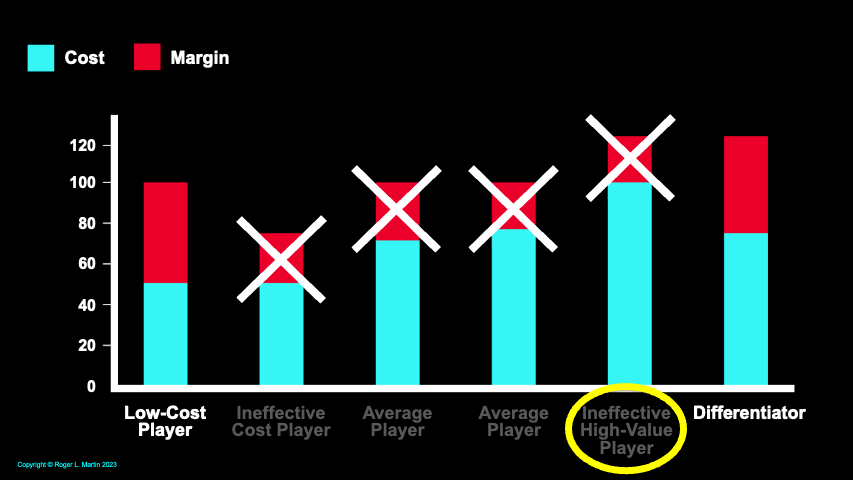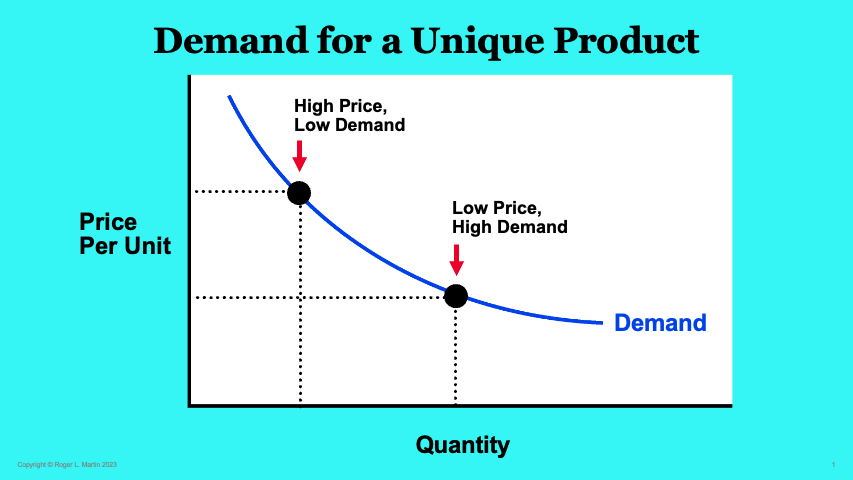Playing To Win
Cost-Effective Differentiation
Why it Really Matters for your Strategy

Sessions at a client last week and then another one this week reminded me of the importance of cost-effective differentiation. The threat of becoming an ineffective high-value player is always lurking. That is why I have dedicated my 13th Year III Playing to Win Practitioner Insights (PTW/PI) piece to Cost-Effective Differentiation: Why it Really Matters for Your Strategy. You can find the previous 123 PTW/PI here.
What Differentiation Is Not
Though it might seem so obvious as to not be worth saying, I would argue from experience that it is important to note that not being a cost leader is not the same as being a differentiator. For countless management teams, when I explain what a low-cost strategy entails — that is, having a cost position that is sustainably and significantly lower than any competitor in its space — they conclude that because that isn’t them, they must be a differentiator. Nope. All it means is that they are not a cost leader.
Others think that they are a cost leader because their cost position is in the general ballpark of other more cost-effective players. Nope. Being cost proximate is not being a cost leader. It is being average cost.
Still others believe that being ‘branded’ means that they are a differentiator. There are lots of brands that are recognized by customers and are preferred over an alternative offer that they don’t know or understand. But they command no price premium. They win over alternatives at the same price and as such are narrowly preferred. That is, they are liked but not truly valued.
What Differentiation Is: Part 1
For a differentiator, a segment of customers goes beyond ‘like’ to ‘value.’ That is, customers will pay a price premium for the differentiator’s offering. And for that segment of customers, it will be a bigger price premium than for anyone else in the market. Obviously, it can’t be true for every customer. Inevitably, some customers will pay more for the offering of some other competitor. But a wide range of customers in the differentiator’s segment will pay more for the uniqueness of the value added by that differentiator. If they won’t, you are just not a differentiator.
What Differentiation Is: Part 2
That is half the work of being a differentiator — earning a price premium for your offer. The second part is having a cost position that enables you to earn bigger margins than competitors that compete for your target customer segment, other than the cost leader in the business, if there is one. Often, there isn’t a cost leader in a business, just competitors with cost positions around the average of the industry. If there is a cost leader with as large a margin as the differentiator, the differentiator will need to figure out how to co-exist with the cost leader most productively. Each of the differentiator and the cost leader will appeal to their segments of customers and trying not to fight unproductively is the task in such industries (but perhaps more on this subject in a future post).
Many management teams ask me why I am so obsessed about the differentiator having a cost position that results in the highest margin. It is because the only two kinds of players that aren’t competitively jerked around by someone else in the industry are the differentiator and the cost leader. The true differentiator (as illustrated by the right-most bar in the above illustration) can always steal share by lowering its price premium and still earn a bigger margin than everyone in the middle, who, in the end, have no choice but to cede share. In similar fashion, the cost leader (as illustrated by the left-most bar) can always steal share by cutting price, while still earning an attractive margin.
The players in the middle can’t do a thing about it. That is the story of cost leader Southwest Airlines, which has grown inexorably from a tiny, insignificant local Texas carrier to the #1 in passenger seat-miles in America — and the mainline airlines were powerless to stop Southwest. It is also the story of differentiator Tide — the rest of the US detergent industry has been powerless to stop it.
Some argue that these rules don’t apply if you invent a new industry. Essentially, you are the monopolist. If you have invented a stupid industry, then neither will anyone enter, nor will you be successful. However, if you invent a great one, myriad competitors will enter to participate in the greatness you created. Vanguard created the index mutual fund industry in 1976. Now index funds account for over 20% of the mutual fund/Exchange Traded Fund (ETF) business. The index fund market is a multi-trillion-dollar industry, and there are hundreds of competitors. But Vanguard is still the cost leader and the #1 player. Facebook (largely) created the business of social networking featuring user-generated-content, but because that turned out to be a good idea, highly valued by users, it now faces plenty of tough competitors.
Competition is inevitable. If you want to continue to prosper, you have no choice but to be ready as either a true differentiator or a cost leader.
Cost Position Consequences
The way to think about the consequences of a high-value player not having a competitive cost position borrows from the economics of commodity industries as illustrated in the graphic below:

The general rule (though I don’t want to exaggerate the case to be universal) is that cost position (on the delivered cash cost curve) is inversely correlated with capacity utilization in businesses that tend to be viewed as commodities. That is, the competitor with the lowest cost position (Firm A on the chart) will sell out its entire capacity without any effort. That is because if any discount is required, it is done with barely a thought because Firm A has so much margin to work with between its cost and the market price. The next lowest (Firm B) will almost have the same ease of selling its full capacity. The next, Firm C, will have some challenges and likely operate at a lower capacity utilization. And the marginal player (Firm D) will have a heck of a time getting anywhere close to capacity utilization.
I was on the board once (sigh, not a happy experience) of a company competing in the EMS (for electronic manufacturing services) business, a very cost sensitive business in which big computer players (IBM, HP, Dell) outsourced manufacturing to EMS players (in fact, many did so by selling their plants to EMS companies). Think of the chart above as alternatively representing the various production facilities of a single firm. For this company, Plant D was the perpetually underperforming plant in the network. In board meeting after board meeting, we heard presentations from management about how it intended to focus the sales efforts on ‘loading up’ Plant D so that its profitability would improve. But no amount of effort ever moved the capacity utilization dial one degree.
The problem was that the company had a target margin for what it sold. And when it added that target margin to its costs, very few customers wanted to buy the product at that price (I predicted it, but management had zero interest in strategy, and I exited in disgust shortly before the CEO exited by way of termination — double-sigh).
The same exactly holds with the ineffective high-value player. Real differentiators have the margin room to be aggressive with pricing when needed and, in addition, have the earnings from their high margins to invest in the next differentiation. And low-cost players can grab share by pricing below the level that any other player is game to match. Consequently, ineffective high-value players have difficulty growing. Customers who happen to really value their particular offering remain loyal customers at the price they need to charge. But as with all companies, ineffective high-value players face a downward-sloping demand curve in which higher prices mean lower demand.

Simply, the ability to grow any business is hampered by needing to charge a high enough price to earn a return on costs. If those costs are higher than they need to be, but you add value to a set of customers, you will have a decent business. But it won’t be a great business.
And in the modern world, the cost-ineffective high-value player will be squarely in the gunsights of private equity (PE). PE loves nothing (and I mean, not a single thing) more than a business that has an attractive product/service but crummy cost position. Because its profitability will be OK but nothing special, it can be bought at reasonable multiple of current earnings. The PE firm will come in and knock the excess costs out and, often, make a huge return on selling the improved company to a strategic buyer or taking it back to the public markets. Of course, sometimes PE destroys it, as with Toys R Us or Clear Channel, but they have way more successes than failures, so they keep at it. The fifth bar of the introductory chart has been worth probably over a trillion dollars for PE, and the hits keep coming…
Practitioner Insights
The core insight is pretty simple: Seeking to be a differentiator isn’t a license to not worry about costs. It is all one singular value equation. The determinant of your competitiveness is the margin between the value you create and the costs you incur. And in that metric: a buck is a buck is a buck.
I was fortunate to get excellent training on this front. My entrepreneurial father created the differentiator in his industry (animal feed in Ontario, Canada). The company had unquestionably the highest quality and best service. But he was a bear on costs, and the following is one of many such examples. He owned the business but never had his own office — that is right, the owner/CEO didn’t have an office. His rationale, which he maintained from the many years during which it was a struggling start-up to the time it had become the industry leader, was that there would always be an empty office that he could use while its occupant was elsewhere. That was, by the way, decades earlier that the arrival of the modern world of office hoteling.
His logic was that office-hopping didn’t hurt his ability to be an effective CEO and the customers didn’t benefit from him spending on a classically huge CEO’s office. Nice strategy thinking, Dad!
So all you differentiators out there, take as much pride in cost effectiveness as in customer value creation. They are the two sides of the same differentiation coin. It is, arguably, a trickier task than that of the cost leader. You have to think about how to innovate value on behalf of your customers and figure out how to do it at a cost that makes your pricing highly competitive for growth. It is hard, but the reward is worth it.
